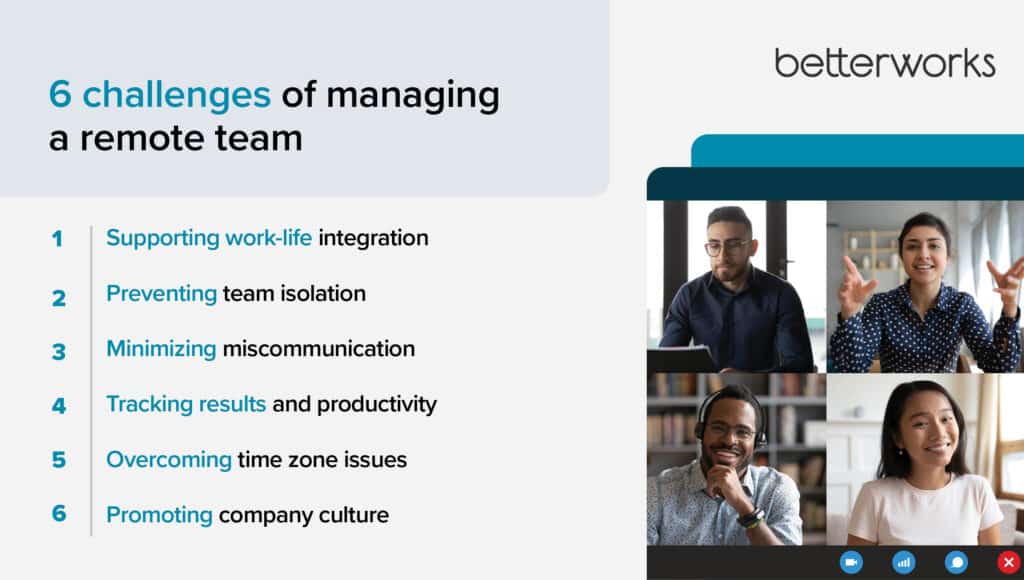Remote and hybrid work isn’t going away anytime soon, and forward-thinking business leaders recognize they need a new approach to effective remote workforce management. HR professionals play a crucial role in helping managers unlock better communication, productivity, and business results within their teams.
Even as offices reopen and occupancy rates trend upward, remote work has become a permanent feature of many people’s work lives. Three times as many Americans worked remotely last year than in 2019, and Gallup estimates that 22% of remote-capable jobs will remain exclusively remote going forward. Many of these people expect to stay remote and will look for other jobs if forced to work on-site.
Employers have a choice: Find a way to meet the needs of their remote employees, or risk employee dissatisfaction and turnover by forcing unhappy people back into offices.
Let’s explore what it takes to manage a remote team, some of the most common challenges, and how managers can more effectively serve remote employees.
What is remote workforce management?
Remote workforce management means managing employees who don’t work at centralized worksites. While some of these employees are exclusively remote, others split their time as part of a hybrid workplace. Many organizations have large percentages of their employees working remotely at least part time, creating an imperative to develop a remote workforce management infrastructure.
Not every remote experience is the same. Some employees might find their daily work unchanged; others experience huge differences in their day-to-day tasks and interactions. A robust remote work infrastructure empowers managers with the communication, processes, and technology they need to lead remote teams successfully.
Pros of working remotely
Remote work has been successful for decades and has gotten new respect and adoption since the pandemic forced companies to change their work models overnight. Here are some of the core benefits remote work can provide.
Better work-life balance
People have reevaluated their priorities since the COVID-19 pandemic began, and many prioritize better work-life balance. In fact, this concept has evolved. What people seek today is work-life integration, which simply means being able to conduct activities in a way that is optimal for both work and personal life.
Remote work helps many people control how their days are structured, enabling them to be productive and efficient at work while also addressing other needs and responsibilities in the flow of their work.
Of course, this work-life integration is only possible when employees have autonomy, a sensible workload, and sufficient resources. Remote work can contribute to better work-life integration but is insufficient without strong management practices and a culture that prioritizes the whole person at work.
Higher productivity
Remote workers have long been able to get their work done without being in the office or at a worksite, and that trend has continued into the pandemic, despite some managers’ reservations. In the first year of the pandemic, 67% of workers surveyed by Owl Labs said productivity increased, with only 1% believing they were much less productive.
More recent data from Microsoft WorkLab finds that 80% of employees believe they are more productive when working remotely. This could result from employees feeling empowered to set their own schedules. The report notes, “Productivity patterns in Outlook show people are becoming more intentional about taking breaks, avoiding double booking, and establishing meeting-free work blocks.”
Flexibility
While not exclusive to remote work, flexibility is a highly valued benefit of these arrangements. A Buffer survey found that people valued two forms of flexibility — how they spent their time and where they chose to work.
Many workers find value in structuring their schedules to accommodate such tasks as picking up a child, attending doctor’s appointments, or running errands — all without taking paid time off or unpaid leave.
Cons of working remotely
Work can be challenging wherever it occurs, but remote workers are especially prone to certain obstacles. Here are a few potential downsides of virtual work.
Lack of focus
People working remotely can suffer from distractions or lack focus, especially when working from a crowded home or juggling family responsibilities. Caregivers, for example, might be challenged to balance work-related demands with the needs of their loved ones. Other distractions cited by Superhuman’s State of Your Inbox Study include people’s phones, breaking news, and social media.
Remote workers are more at risk for these downsides when they are overworked, lack dedicated office space, or are otherwise stressed or tired.
Isolation
Loneliness and isolation can be a problem for remote workers who are used to on-site social interactions. For some people, work might be their primary social outlet. Remote workers can struggle to connect with their colleagues without the right social structure, amplifying that sense of loneliness.
Remote workers can also become isolated when managers are biased toward on-site workers. These leaders inadvertently or deliberately exclude off-site workers from crucial information, plum assignments, and advancement opportunities.
Poor technology access
The benefit of going to a central worksite is that employers generally provide the necessary technology, including internet access. Many remote workers use their personal devices, which can cost them money and introduce cybersecurity issues.
High-speed internet access remains a challenge for millions of Americans. According to the Federal Communications Commission, nearly 25% of rural Americans lack access to high-speed fixed broadband. Workers who lack dependable technology and internet service — or the financial means to obtain it — are disadvantaged in an increasingly digital economy.
6 common challenges of managing a remote team
Managers who work with remote teams have likely encountered challenges with miscommunication, feelings of isolation, tracking results and productivity, or keeping connected across time zones.
These are common challenges in remote work, but challenges that you can overcome to empower better remote workforce management.
Training managers to support work-life integration
Remote work can help people get their work done without feeling they are neglecting personal and family responsibilities. But employees only have so much control; they need their managers to support work-life integration.
If workers feel like they are always on call, they become stressed or suffer from burnout. Managers contribute to the problem when they communicate off-hours, overload employees, or set unreasonable expectations — or show bias outright against at-home employees.
Train managers to be mindful of each team member’s workload and need for paid time off. If an employee consistently works long hours, managers should explore why that is. Is their workload too heavy? Do they need more training? Are they working efficiently? Are they beginning to disengage?
Managers are employees, too, and they can also suffer from the strains of overwork and burnout. Ensure they have the training and resources to lead productive conversations with team members about work-life challenges.
Preventing team isolation
Well-being has become a bigger priority for many workers since the beginning of the pandemic, according to the Microsoft New Future of Work Report, and remote work has a complicated relationship with well-being. While remote work can improve job satisfaction and autonomy, “employees may feel socially isolated, guilty and try to overcompensate.”
Goal alignment can help workers feel more connected to each other and the work. Employees who feel part of a team working toward shared goals will gain a better sense of purpose and connection.
Managers can intervene to help remote workers feel connected, too. For example, offering regular coaching and feedback to people in team meetings and check-ins can build relationships, trust, and connection. Managers can show employees that they value mental health by directing them to the company’s resources and benefits, such as an employee assistance program.
Minimizing miscommunication
Virtual interactions can lead to miscommunication because people cannot read tone of voice or body language as cues in chat apps and email, which are often replacements for in-person contact. While these are popular asynchronous forms of communication that enable flexibility for remote work, they are are insufficient for some situations.
Your organization should have communication maps that guide people on when to escalate a situation, much like those to handle emergencies. These maps should illustrate the contact point(s), the method of communication and what to do if that attempt is unsuccessful. Such documentation can be beneficial for people who can’t walk over and have a casual conversation with a nearby co-worker — and keeps them from being left out of the loop.
For developmental communication, such as check-ins or performance conversations, video conferencing software can help managers communicate with remote employees, although phone calls without video can also be effective. Schedule these conversations rather than using video calls as an ad hoc method.
Tracking results and productivity
According to research presented at the Chase ’22 software engineering conference, employees and managers often define productivity differently. Managers were more likely to define productivity as outcomes (the work completed), while employees were more likely to define it as output (the actions taken to achieve outcomes).
These different perspectives on productivity make it more challenging to track remote work. Managers need to define productivity with their teams so they understand expectations, the tasks to complete, and how progress will be measured. Using remote team management software can streamline this process by providing tools to set clear expectations, track progress, and facilitate real-time communication, ensuring that both managers and employees stay aligned on productivity goals.
Overcoming time zone issues
One advantage of remote work is that employers can hire from a wider geographical area. But managing people across many time zones presents unique challenges, including a lack of overlapping working hours. Conflict can arise when a project or meeting requires everyone to be present, regardless of their local time.
Managers can minimize these challenges by encouraging flexible working hours and asynchronous communication tools. Communication should be documented whenever possible and made accessible so that even when people can’t work the same hours, they can work off the same knowledge.
Promoting company culture
Remote work potentially offers fewer opportunities for building company culture if workers don’t interact with or even know their co-workers.
Business leaders are responsible for cultivating company culture, starting with a strong vision and firm, clear values. Your culture is the net result of everyone’s interactions at work. By reinforcing shared vision and values, business leaders set the tone for employees’ behaviors and interactions.
Managers play a crucial role in tactically reinforcing culture in their employees’ day-to-day work and behaviors.

10 best practices for managing a remote workforce
Managing a remote team requires communication, decisiveness, and accountability, just like any other management role. HR leaders should help managers continue to lead while adjusting for the distinct differences of remote work.
Here are 10 tips that help managers guide and develop remote employees.
Trust your team
High-functioning remote teams are driven by trusting relationships between managers and employees.
Managers build trust within their teams by facilitating transparent communication and outlining shared goals. When performance expectations are clear, managers can trust their employees to pursue them in the ways they see fit, following up with regular check-ins and feedback to keep everyone aligned.
When managers support their teams’ pursuit of goals instead of micromanaging where work is performed, employees will trust the process.
Find the right people for the role
Not everyone wants to work remotely. When hiring, look for candidates with proven remote work experience or a track record of working independently within an office setting. Be clear in your job listings whether a job is remote, hybrid, or on-site so candidates can choose what works for them.
Within that pool of people eager to work remotely, however, focus more on the role itself. Don’t overlook qualified candidates by making assumptions, such as assuming extroverts will struggle at home.
Communicate often
Consistent communication is the backbone of the remote work model, and getting this right starts with regularly scheduled check-ins.
Managers can check in with employees weekly to address workload concerns, assignment questions, or roadblocks. Train managers to communicate effectively within the flow of work, too. Some comments might be best served in an email or call, while others might land best within your project management software or a shared document.
Establish a transparent chain of command for questions and feedback so employees know who to reach out to in any given scenario.
Be clear with expectations
Effective performance management for remote teams requires clearly defined goals and performance expectations.
Expectations can be set to any number of work-related activities, including onboarding, quarterly performance conversations, projects, or career development conversations.
Managers should put expectations in writing whenever possible for all employees. Follow up with check-ins to clarify employees’ understanding of their commitments and how progress will be measured.
Establish transparent feedback
Many employees welcome feedback but rarely receive it. The Betterworks 2022 State of Performance Enablement report found that one-third of surveyed employees have two or fewer check-ins annually with a direct manager for feedback, coaching, and goal progression. Another 10% said they rarely or never receive this kind of feedback.
Feedback from managers is essential, especially for remote employees. Regular check-ins should discuss work quality, productivity, overall work satisfaction, as well as address any work barriers the employee might be facing. Managers and employees may also talk about professional development and expectations.
Create a clear structure for your team
Remote teams don’t have the luxury of ad hoc conversations to overcome poor processes or unclear organizational structures. All employees should understand how their team, department, and organization are structured and the company’s stated policies and procedures.
Employees feel more connected to their teammates if they know everyone is working to reach the same goals under the same organizational framework. Use team meetings, memos, and other forms of communication to connect employees to their colleagues’ work and overall goals.
Invest in employee training and development
Employee training and development can fill skills gaps and prepare employees for their next role. While hands-on training might not be easily achievable in a remote setting, managers have many avenues for ensuring their remote teams can learn, explore, and grow within the workplace.
Employees who receive training and development will increase their loyalty to the organization because they believe the company and manager are investing in them. Don’t confuse this with perks. Training and learning offer long-term benefits to satisfy employees’ ambitions rather than provide fun activities or smooth over other problems.
Develop a remote work policy
Remote work policies codify your organization’s expectations. They should include expectations of working hours, communication practices, legal rights and obligations, cybersecurity requirements, and more. These policies should also clarify what job roles and jurisdictions are approved for remote work.
Remote work policies ensure everyone is treated fairly and held to the same standards. Like any organizational policy, they’re an essential part of governance.
Invest in the right tools
Investing in your team’s tools and technology is almost as important as designing the right remote work infrastructure.
Performance management platforms help employers and employees track objectives and key results (OKRs) and maintain productivity. Employees and managers can track and record progress toward their goals.
Organizations might also invest in tools such as remote-access security, HR, payroll and accounting platforms, communication tools, and sales platforms.
Promote wellness
The past two years have increased focus on physical, mental, and emotional health. Remote workers might need help setting boundaries and determining what schedules and work habits they need off-site.
Train managers to value their employees’ physical and mental health and help them understand the dangers of burnout. Educate all employees about wellness benefits they may be unaware of, including those related to mental health.
Cultivate a wellness culture where managers lead by example. Reinforce good habits, like taking paid time off, limiting work to within set hours, and living a healthy lifestyle.
Remote workforce management engages your teams
Organizations with a structured approach to remote work will unlock the benefits while avoiding the isolation, miscommunication, and lost productivity that can hamper less thoughtful organizations.
What works best for your organization will evolve based on trial and error, new technologies, and new insights about team management. Stay alert to the changing needs of your workforce, and help managers put their people first regardless of location. Over time, you’ll see why remote workforce management is imperative for any modern organization looking to make work better.
Want to learn more about managing remote workforces? Get advice on aligning and motivating a remote workforce.


